light SKODA OCTAVIA TOUR 2009 1.G / (1U) Owners Manual
[x] Cancel search | Manufacturer: SKODA, Model Year: 2009, Model line: OCTAVIA TOUR, Model: SKODA OCTAVIA TOUR 2009 1.G / (1U)Pages: 224, PDF Size: 13.53 MB
Page 161 of 224
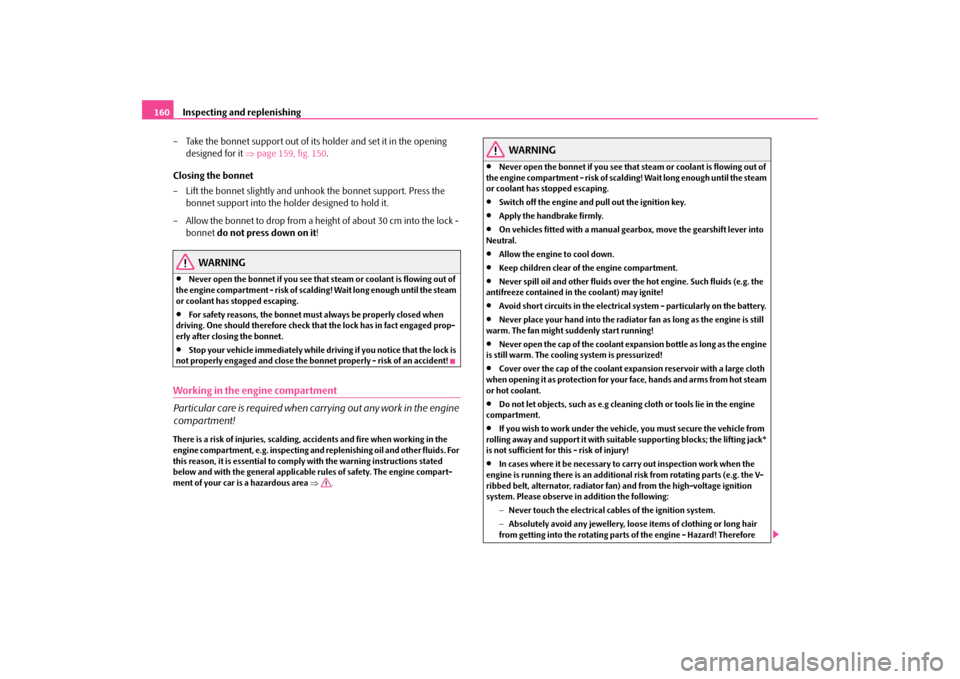
Inspecting and replenishing
160
– Take the bonnet support out of its holder and set it in the opening
designed for it
⇒
page 159, fig. 150
.
Closing the bonnet – Lift the bonnet slightly and unhook the bonnet support. Press the
bonnet support into the hold
er designed to hold it.
– Allow the bonnet to drop from a height of about 30 cm into the lock -
bonnet
do not press down on it
!
WARNING
•
Never open the bonnet if you see that steam or coolant is flowing out of
the engine compartment - risk of scaldi
ng! Wait long enough until the steam
or coolant has stopped escaping.•
For safety reasons, the bonnet must always be properly closed when
driving. One should therefore check that
the lock has in fact engaged prop-
erly after closing the bonnet.•
Stop your vehicle i
mmediately while driving if yo
u notice that the lock is
not properly engaged and close the bonn
et properly - risk of an accident!
Working in the engine compartment Particular care is required when ca
rrying out any work in the engine
compartment!There is a risk of injuries, scalding,
accidents and fire wh
en working in the
engine compartment, e.g. inspecting an
d replenishing oil and other fluids. For
this reason, it is essential to comply with the warning instructions stated below and with the general applicable
rules of safety. The engine compart-
ment of your car is a hazardous area
⇒
.
WARNING
•
Never open the bonnet if you see that steam or coolant is flowing out of
the engine compartment - risk of scaldi
ng! Wait long enough until the steam
or coolant has stopped escaping.•
Switch off the engine and pull out the ignition key.
•
Apply the handbrake firmly.
•
On vehicles fitted with a manual gearbox, move the gearshift lever into
Neutral.•
Allow the engine to cool down.
•
Keep children clear of the engine compartment.
•
Never spill oil and other fluids over the hot engine. Such fluids (e.g. the
antifreeze contained in the coolant) may ignite!•
Avoid short circuits in the electrical system - particularly on the battery.
•
Never place your hand into the radiator
fan as long as the engine is still
warm. The fan might suddenly start running!•
Never open the cap of the coolant expa
nsion bottle as long as the engine
is still warm. The cooling system is pressurized!•
Cover over the cap of the coolant expansion reservoir with a large cloth
when opening it as protection for your face, hands and arms from hot steam or hot coolant.•
Do not let objects, such as e.g cleaning cloth or tools lie in the engine
compartment.•
If you wish to work under the vehicl
e, you must secure the vehicle from
rolling away and support it
with suitable supporting blocks; the lifting jack*
is not sufficient for this - risk of injury!•
In cases where it be necessary to carry out inspection work when the
engine is running there is an additional risk from rotating parts (e.g. the V- ribbed belt, alternator, radiator fan) and from the high-voltage ignition system. Please observe in addition the following:
− Never touch the electrical cabl
es of the ignition system.
− Absolutely avoid any jewellery, loose items of clothing or long hair from getting into the rotating part
s of the engine - Hazard! Therefore
s2g8.b.book Page 160 Tuesday, April 7, 2009 8:53 AM
Page 164 of 224
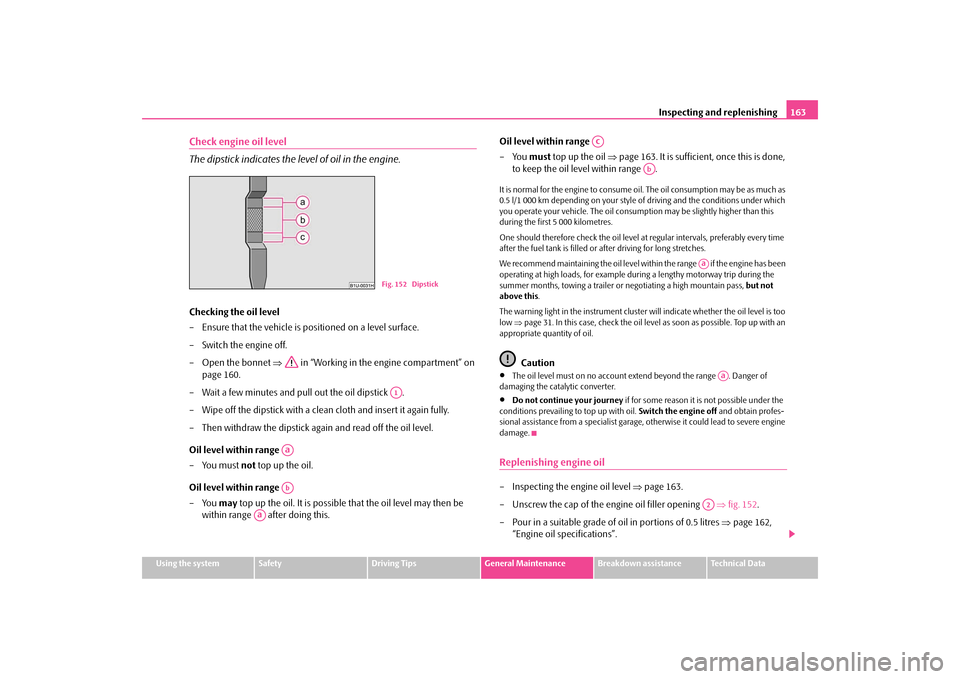
Inspecting and replenishing
163
Using the system
Safety
Driving Tips
General Maintenance
Breakdown assistance
Technical Data
Check engine oil level The dipstick indicates the level of oil in the engine.Checking the oil level – Ensure that the vehicle is positioned on a level surface. – Switch the engine off.– Open the bonnet
⇒
in “Working in the engine compartment” on
page 160.
– Wait a few minutes and pull out the oil dipstick . – Wipe off the dipstick with a clea
n cloth and insert it again fully.
– Then withdraw the dipstick ag
ain and read off the oil level.
Oil level within range – You must
not
top up the oil.
Oil level within range – You
may
top up the oil. It is possible that the oil level may then be
within range after doing this.
Oil level within range –You
must
top up the oil
⇒
page 163. It is sufficient, once this is done,
to keep the oil level within range .
It is normal for the engine to consume oi
l. The oil consumption may be as much as
0.5 l/1 000 km depending on your style of driving and the conditions under which you operate your vehicle. The oil consumpt
ion may be slightly higher than this
during the first 5 000 kilometres. One should therefore check the oil level at regular intervals, preferably every time after the fuel tank is filled or after driving for long stretches. We recommend maintaining the oil level within the range if the engine has been operating at high loads, for example during a lengthy motorway trip during the summer months, towing a trailer or
negotiating a high mountain pass,
but not
above this
.
The warning light in the instrument cluster
will indicate whether the oil level is too
low
⇒page 31. In this case, check the oil level
as soon as possible. Top up with an
appropriate quantity of oil.
Caution
•
The oil level must on no account ex
tend beyond the range . Danger of
damaging the cata
lytic converter.
•
Do not continue your journey
if for some reason it is not possible under the
conditions prev
ailing to top up with oil.
Switch the engine off
and obtain profes-
sional assistance from a specialist garage, otherwise it could lead to severe engine damage.Replenishing engine oil– Inspecting the engine oil level
⇒
page 163.
– Unscrew the cap of the engine oil filler opening
⇒
fig. 152
.
– Pour in a suitable grade of oil in portions of 0.5 litres
⇒
page 162,
“Engine oil specifications”.
Fig. 152 DipstickA1
AaAb
Aa
Ac
Ab
Aa
Aa
A2
s2g8.b.book Page 163 Tuesday, April 7, 2009 8:53 AM
Page 167 of 224
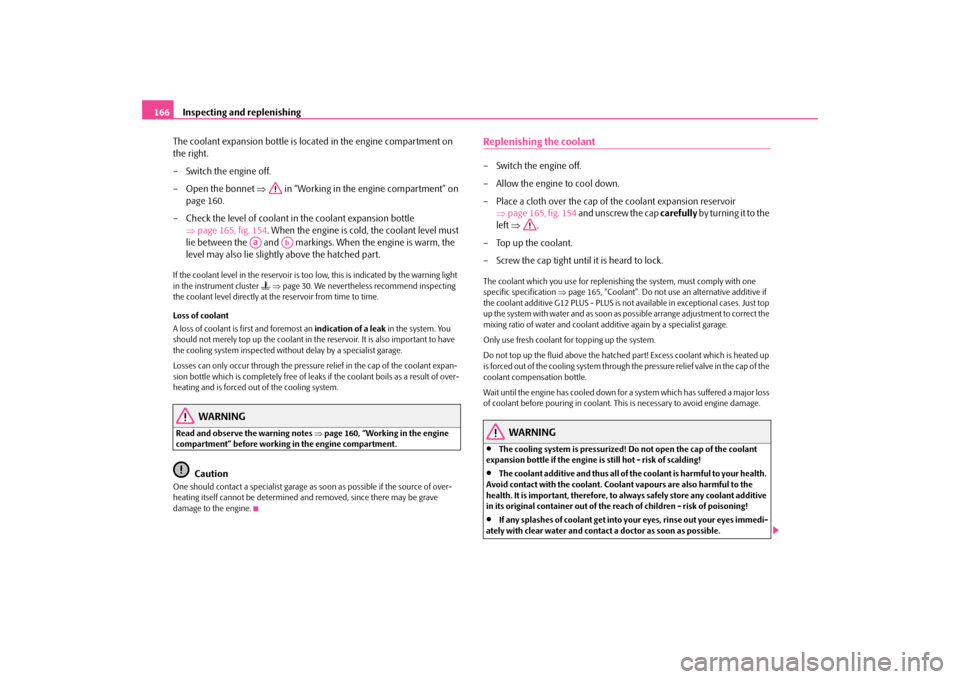
Inspecting and replenishing
166
The coolant expansion bottle is loca
ted in the engine compartment on
the right. – Switch the engine off. – Open the bonnet
⇒
in “Working in the engine compartment” on
page 160.
– Check the level of coolant in the coolant expansion bottle
⇒
page 165, fig. 154
. When the engine is cold, the coolant level must
lie between the and markings. When the engine is warm, the level may also lie slightly above the hatched part.
If the coolant level in the reservoir is too low, this is indicated by the warning light in the instrument cluster
⇒page 30. We nevertheless recommend inspecting
the coolant level directly at th
e reservoir from time to time.
Loss of coolant A loss of coolant is first and foremost an
indication of a leak
in the system. You
should not merely top up the coolant in the reservoir. It is also important to have the cooling system inspected without delay by a specialist garage. Losses can only occur through the pressure
relief in the cap of the coolant expan-
sion bottle which is completely free of leak
s if the coolant boils as a result of over-
heating and is forced out of the cooling system.
WARNING
Read and observe the warning notes
⇒page 160, “Working in the engine
compartment” before working in the engine compartment.
Caution
One should contact a specialist garage as soon as possible if the source of over-heating itself cannot be
determined and removed, since there may be grave
damage to the engine.
Replenishing the coolant– Switch the engine off. – Allow the engine to cool down. – Place a cloth over the cap of the coolant expansion reservoir
⇒
page 165, fig. 154
and unscrew the cap
carefully
by turning it to the
left
⇒
.
– Top up the coolant. – Screw the cap tight until it is heard to lock.The coolant which you use for replenishing the system, must comply with one specific specification
⇒page 165, “Coolant”. Do not use an alternative additive if
the coolant additive G12 PLUS - PLUS is not av
ailable in exceptional cases. Just top
up the system with water and as soon as possible arrange adjustment to correct the mixing ratio of water and coolant additive again by a specialist garage. Only use fresh coolant for topping up the system.Do not top up the fluid above the hatched
part! Excess coolant which is heated up
is forced out of the cooling system through the pressure relief valve in the cap of the coolant compensation bottle. Wait until the engine has cooled down for a system which has suffered a major loss of coolant before pouring in coolant. This is necessary to avoid engine damage.
WARNING
•
The cooling system is pressurized! Do not open the cap of the coolant
expansion bottle if the engine is
still hot - risk of scalding!
•
The coolant additive and thus all of the coolant is harmful to your health.
Avoid contact with the coolant. Coolant vapours are also harmful to the health. It is important, therefore, to always safely store any coolant additive in its original container out of the reach of children - risk of poisoning!•
If any splashes of coolant get into yo
ur eyes, rinse out
your eyes immedi-
ately with clear water and contact a doctor as soon as possible.
Aa
Ab
s2g8.b.book Page 166 Tuesday, April 7, 2009 8:53 AM
Page 168 of 224

Inspecting and replenishing
167
Using the system
Safety
Driving Tips
General Maintenance
Breakdown assistance
Technical Data
•
You should also consult a doctor without delay if you have inadvertently
swallowed coolant.
Caution
Do not continue your journey if for some reason it is not possible under the conditions prevailing to top up with coolant. Switch the engine off
and obtain
professional assistance from a specialist garage, otherwise it could lead to severe engine damage.
For the sake of the environment
Do not re-use coolant if it is necessary to
drain the coolant in the system. It should
be collected and disposed of in comp
liance with environmental protection
regulations.Radiator fan The radiator fan may switch on suddenly.The radiator fan is driven by an electr
ic motor and controlled according to the
coolant temperature. The radiator fan may continue running fo
r up to 10 minutes after the engine has
been switched off - even if
the ignition is also off. It
may also switch on suddenly
after a certain time, if•
the coolant temperature has risen beca
use of an accumulation of heat or
•
the warm engine compartment is heated
up additionally by
strong sunlight.
WARNING
You must therefore be aware when work
ing in the engine compartment that
the fan may switch on suddenly - risk of injury!
Brake fluidInspecting the brake fluid levelThe brake fluid reservoir is located on the left of the engine compartment. The brake fluid reservoir on right-hand steering models is positioned on the other side of the engine compartment. – Switch the engine off.– Open the bonnet
⇒
in “Working in the engine compartment” on
page 160.
– Inspect the brake fluid level in the reservoir
⇒
fig. 155
. The level must
be between the “MIN” and “MAX” markings.
A slight drop in the fluid level results when driving due to normal wear-and-tear and automatic adjustment of the br
ake pads, and is perfectly normal.
There may be an indication of a leak in the brake system, however, if the fluid level drops significantly within a short time or if it drops below the “MIN” marking. A situ- ation where the brake fluid level is too low is indicated by the warning light
lighting up in the instrument cluster
⇒page 34. In this case
stop immediately and
do not drive any further! Obtain professional assistance.
WARNING (continued)
Fig. 155 Engine compart- ment: Brake fluid reservoir
s2g8.b.book Page 167 Tuesday, April 7, 2009 8:53 AM
Page 170 of 224

Inspecting and replenishing
169
Using the system
Safety
Driving Tips
General Maintenance
Breakdown assistance
Technical Data
WARNING
•
The battery acid is strongly corros
ive and must, therefore, be handled
with the greatest of care. Always we
ar protective gloves, eye and skin
protection when handling batteries. Corrosive fumes in the air irritate the air passages and lead to conjunctivitis
and inflammation of the air passages
in the lungs. Battery acid corrodes
dental enamel and creates deep wounds
after contact with the skin which take a long time to heal. Repeated contact with diluted acids causes skin diseases (inflammations, ulcers, slin cracks). Acids coming into contact with water are diluted accompanied by significant development of heat.•
Do not tilt the battery otherwise battery electrolyte may flow out of the
battery vent openings. Prot
ect the eyes with safety glasses or a shield! There
is the danger of suffering blindness! If
any battery electrol
yte gets into your
eye, rinse out your eye immediately
with clear water for several minutes.
Contact a doctor without delay.•
Splashes of acid on your skin or clothes should be neutralised as soon as
possible using soap suds and then rinsed with plenty of water. Contact a doctor immediately if you swallow battery electrolyte.•
Keep batteries out of the reach of children.
•
Hydrogen is released when you char
ge a battery and a highly explosive
gas mixture is produced. An explosion
can be caused through sparkling over
during unclamping or loosening of the cable plug while the ignition is on.•
Bridging of the poles will create a short circuit (e.g. through metal
objects, cables). Possible consequences of a short circuit: Melting of lead struts, explosion and burning of the battery, jets of acid spurting out.•
It is prohibited to work with a naked flame and light, to smoke or to carry
out any activities which produce sparks. Avoid creating sparks when working with cables and electrical device
s. Strong sparking represents a risk
of injury.•
Before carrying out any work on the electrical system, switch off the
engine, the ignition as well as all electrical components and disconnect the negative cable (-) on the battery. If you wish to replace a bulb it is sufficient to switch off the appropriate light.
•
Never charge a frozen or thawed battery - risk of explosion and caustic
burns! Replace a frozen battery.•
Never use a battery which is damaged
- risk of explosion! Immediately
replace a damaged battery.
Caution
•
You must only disconnect the battery if the ignition is switched off, otherwise
the electrical system (electronic components) of the vehicle may be damaged. When disconnecting the battery from the el
ectrical system of the vehicle, first
disconnect the negative terminal (-) of th
e battery. Then disconnect the positive
terminal (+).•
When reconnecting the battery, first conne
ct the positive terminal (+) and only
then the negative terminal (-) of the batt
ery. You must on no account connect the
cables wrongly - risk of a cable fire.•
Ensure that battery acid does not come
into contact with the vehicle body
otherwise damage could
occur to the paintwork.
•
Do not place the battery in direct dayl
ight in order to protect the battery
housing from the effects of ultra-violet light.
For the sake of the environment
A removed battery is a special type of waste which is harmful to the environment - contact your specialist garage regarding disposing of the battery.
Note
Please also refer to the guidelines
⇒page 171, “Disconnecting and reconnecting
the battery”, also after connecting the battery.
WARNING (continued)
s2g8.b.book Page 169 Tuesday, April 7, 2009 8:53 AM
Page 173 of 224
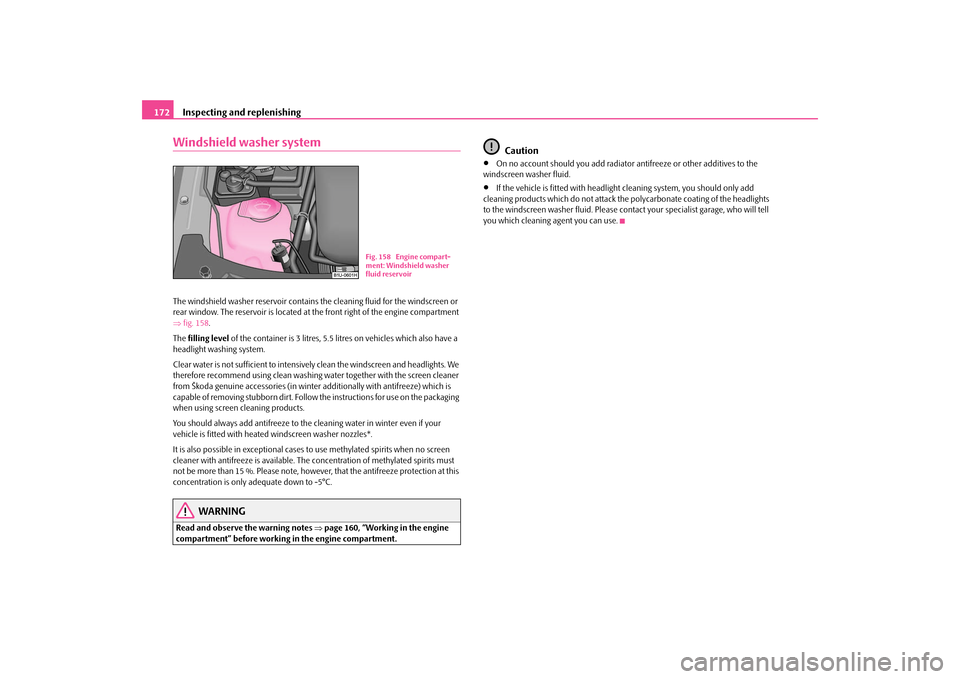
Inspecting and replenishing
172
Windshield washer systemThe windshield washer reservoir contains
the cleaning fluid for the windscreen or
rear window. The reservoir is located at the front right of the engine compartment ⇒ fig. 158
.
The
filling level
of the container is 3 litres, 5.5 li
tres on vehicles which also have a
headlight washing system. Clear water is not sufficient to intensivel
y clean the windscreen
and headlights. We
therefore recommend using clean washing wa
ter together with the screen cleaner
from Škoda genuine accessorie
s (in winter additionally with antifreeze) which is
capable of removing stubborn dirt. Follow
the instructions for use on the packaging
when using screen cleaning products. You should always add antifreeze to the
cleaning water in wi
nter even if your
vehicle is fitted with heated windscreen washer nozzles*. It is also possible in exceptional cases to use methylated spirits when no screen cleaner with antifreeze is
available. The concentration
of methylated spirits must
not be more than 15 %. Please note, howeve
r, that the antifreeze protection at this
concentration is only adequate down to -5°C.
WARNING
Read and observe the warning notes
⇒page 160, “Working in the engine
compartment” before working in the engine compartment.
Caution
•
On no account should you add radiator
antifreeze or other additives to the
windscreen washer fluid.•
If the vehicle is fitted with headlight
cleaning system, you should only add
cleaning products which do not attack th
e polycarbonate coating of the headlights
to the windscreen washer fluid. Please contact your specialist garage, who will tell you which cleaning agent you can use.
Fig. 158 Engine compart- ment: Windshield washer fluid reservoir
s2g8.b.book Page 172 Tuesday, April 7, 2009 8:53 AM
Page 177 of 224
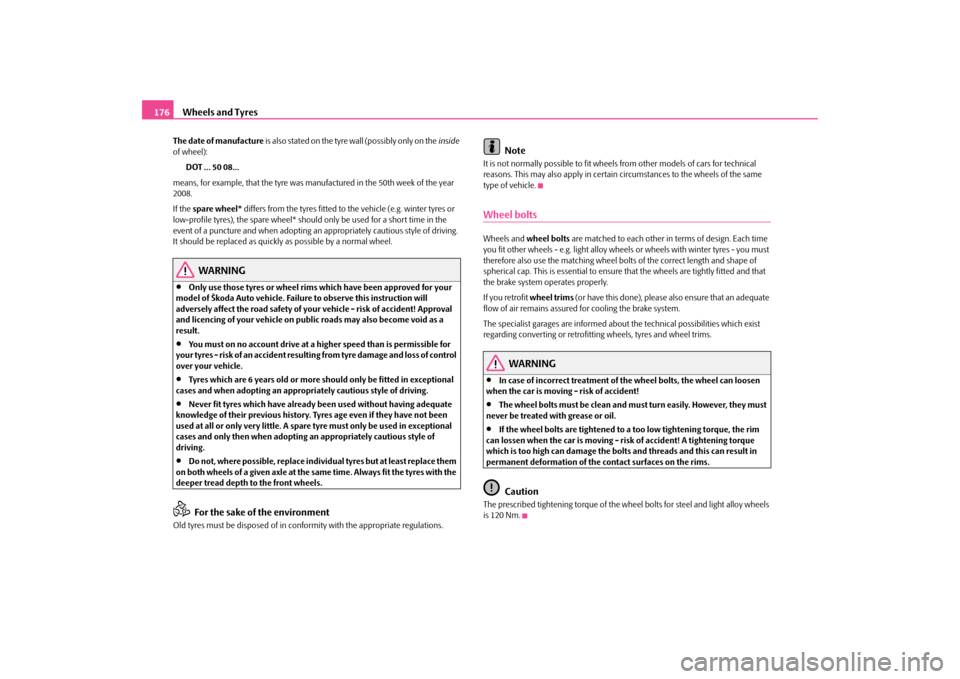
Wheels and Tyres
176
The date of manufacture
is a lso s tated on the tyre wal l (poss ibly o nl y on the
inside
of wheel):
DOT ... 50 08...
means, for example, that the tyre was manufactured in the 50th week of the year 2008. If the
spare wheel*
differs from the tyres fitted to the vehicle (e.g. winter tyres or
low-profile tyres), the spare wheel* should only be used for a short time in the event of a puncture and when adopting an
appropriately cautious style of driving.
It should be replaced as quickl
y as possible by a normal wheel.
WARNING
•
Only use those tyres or wheel rims
which have been approved for your
model of Škoda Auto vehicle. Failure to observe this instruction will adversely affect the road safety of your vehicle - risk of accident! Approval and licencing of your vehicle on public roads may also become void as a result.•
You must on no account drive at a higher speed than is permissible for
y our t yre s - ris k of a n ac cid e n t re su lti ng fro m ty re d a m ag e a nd lo ss o f c ont rol over your vehicle.•
Tyres which are 6 years old or more should only be fitted in exceptional
cases and when adopting an appropriately cautious style of driving.•
Never fit tyres which have already been used without having adequate
knowledge of their previous history. Ty
res age even if they have not been
used at all or only very little. A spare tyre must only be used in exceptional cases and only then when adopting an appropriately cautious style of driving.•
Do not, where possible, replace indivi
dual tyres but at least replace them
on both wheels of a given axle at the same time. Always fit the tyres with the deeper tread depth to the front wheels.
For the sake of the environment
Old tyres must be disposed
of in conformity with the appropriate regulations.
Note
It is not normally possible to fit wheels
from other models of cars for technical
reasons. This may also apply in certain
circumstances to the wheels of the same
type of vehicle.Wheel boltsWheels and
wheel bolts
are matched to each other in
terms of design. Each time
you fit other wheels - e.g. light alloy wheels
or wheels with winter tyres - you must
therefore also use the matching wheel bolts of the correct length and shape of spherical cap. This is essent
ial to ensure that the wheels are tightly fitted and that
the brake system operates properly. If you retrofit
wheel trims
(or have this done), please also ensure that an adequate
flow of air remains assured for cooling the brake system. The specialist garages are informed abou
t the technical possibilities which exist
regarding converting or retrofitti
ng wheels, tyres and wheel trims.
WARNING
•
In case of incorrect treatment of th
e wheel bolts, the
wheel can loosen
when the car is moving - risk of accident!•
The wheel bolts must be clean and must
turn easily. However, they must
never be treated with grease or oil.•
If the wheel bolts are tightened to a too low tightening torque, the rim
can lossen when the car is moving - risk of accident! A tightening torque which is too high can damage the bolts and threads and this can result in permanent deformation of the contact surfaces on the rims.
Caution
The prescribed tightening torque of the wh
eel bolts for steel and light alloy wheels
is 120 Nm.
s2g8.b.book Page 176 Tuesday, April 7, 2009 8:53 AM
Page 184 of 224
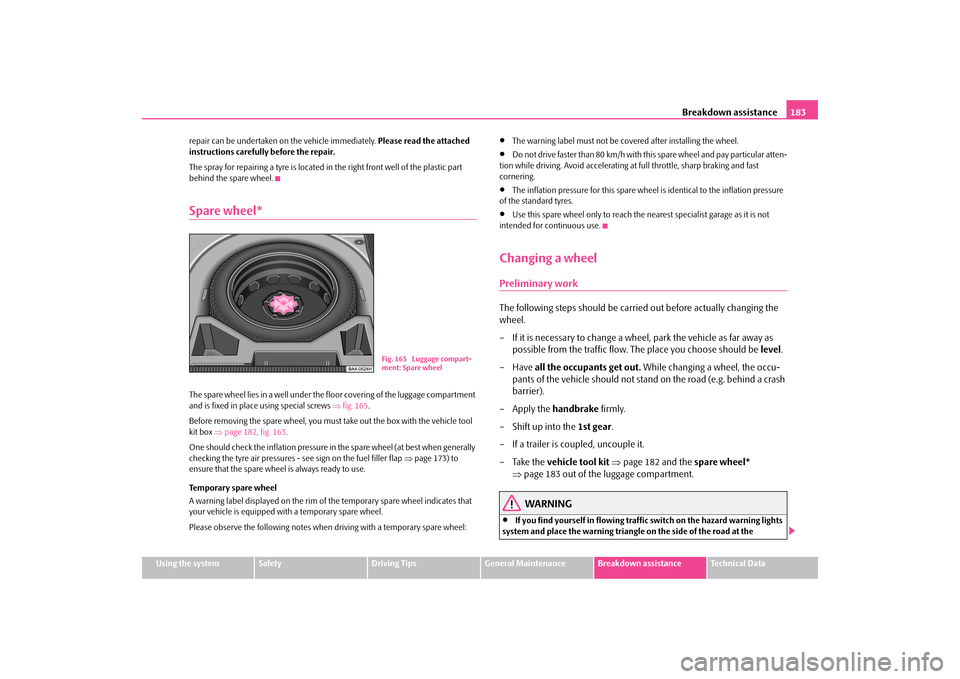
Breakdown assistance
183
Using the system
Safety
Driving Tips
General Maintenance
Breakdown assistance
Technical Data
repair can be undertaken on
the vehicle immediately.
Please read the attached
instructions carefully before the repair. The spray for repairing a tyre is located in
the right front well of the plastic part
behind the spare wheel.Spare wheel*The spare wheel lies in a well under the floor covering of the luggage compartment and is fixed in place using special screws
⇒fig. 165
.
Before removing the spare wheel, you must take out the box with the vehicle tool kit box
⇒page 182, fig. 163
.
One should check the inflation pressure in the spare wheel (at best when generally checking the tyre air pressures - see sign on the fuel filler flap
⇒page 173) to
ensure that the spare wheel is always ready to use. Temporary spare wheel A warning label displayed on the rim of the temporary spare wheel indicates that your vehicle is equipped with a temporary spare wheel. Please observe the following notes when driving with a temporary spare wheel:
•
The warning label must not be covered after installing the wheel.
•
Do not drive faster than 80 km/h with th
is spare wheel and pay particular atten-
tion while driving. Avoid accelerating at full throttle, sharp braking and fast cornering.•
The inflation pressure for this spare wheel is identical to the inflation pressure
of the standard tyres.•
Use this spare wheel only to reach the nearest specialist garage as it is not
intended for continuous use.Changing a wheelPreliminary workThe following steps should be carried out before actually changing the wheel. – If it is necessary to change a wheel, park the vehicle as far away as
possible from the traffic flow. The place you choose should be
level
.
–Have
all the occupants get out.
While changing a wheel, the occu-
pants of the vehicle should not stan
d on the road (e.g. behind a crash
barrier).
– Apply the
handbrake
firmly.
– Shift up into the
1st gear
.
– If a trailer is coupled, uncouple it. – Take the
vehicle tool kit
⇒
page 182 and the
spare wheel*
⇒
page 183 out of the luggage compartment.WARNING
•
If you find yourself in flowing traffic switch on the hazard warning lights
system and place the warning triangle
on the side of the road at the
Fig. 165 Luggage compart- ment: Spare wheel
s2g8.b.book Page 183 Tuesday, April 7, 2009 8:53 AM
Page 185 of 224
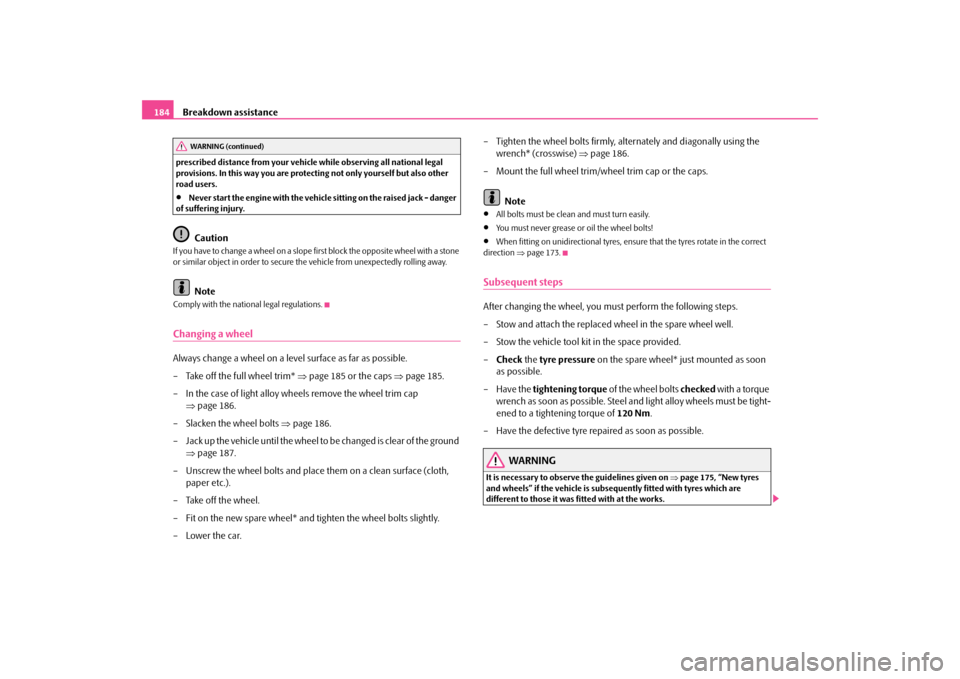
Breakdown assistance
184
prescribed distance from your vehicl
e while observing all national legal
provisions. In this way you are protecting not only yourself but also other road users.•
Never start the engine with the vehicle
sitting on the raised jack - danger
of suffering injury.
Caution
If you have to change a wheel on a slope
first block the opposite wheel with a stone
or similar object in order to secure th
e vehicle from unexpectedly rolling away.
Note
Comply with the national legal regulations.Changing a wheelAlways change a wheel on a level surface as far as possible. – Take off the full wheel trim*
⇒
page 185 or the caps
⇒
page 185.
– In the case of light alloy wheels remove the wheel trim cap
⇒
page 186.
– Slacken the wheel bolts
⇒
page 186.
– Jack up the vehicle until the wheel to
be changed is clear of the ground
⇒
page 187.
– Unscrew the wheel bolts and place them on a clean surface (cloth,
paper etc.).
– Take off the wheel.– Fit on the new spare wheel* and tighten the wheel bolts slightly. –Lower the car.
– Tighten the wheel bolts firmly, al
ternately and diagonally using the
wrench* (crosswise)
⇒
page 186.
– Mount the full wheel trim/w
heel trim cap or the caps.
Note
•
All bolts must be clean
and must turn easily.
•
You must never grease or oil the wheel bolts!
•
When fitting on unidirectional tyres, ensure that the tyres rotate in the correct
direction
⇒page 173.
Subsequent stepsAfter changing the wheel, you must perform the following steps. – Stow and attach the replaced wheel in the spare wheel well. – Stow the vehicle tool kit in the space provided.–
Check
the
tyre pressure
on the spare wheel* just mounted as soon
as possible.
– Have the
tightening torque
of the wheel bolts
checked
with a torque
wrench as soon as possible. Steel and light alloy wheels must be tight-ened to a tightening torque of
120 Nm
.
– Have the defective tyre repaired as soon as possible.
WARNING
It is necessary to observe the guidelines given on
⇒page 175, “New tyres
and wheels” if the vehicle is subseq
uently fitted with tyres which are
different to those it was fitted with at the works.
WARNING (continued)
s2g8.b.book Page 184 Tuesday, April 7, 2009 8:53 AM
Page 187 of 224
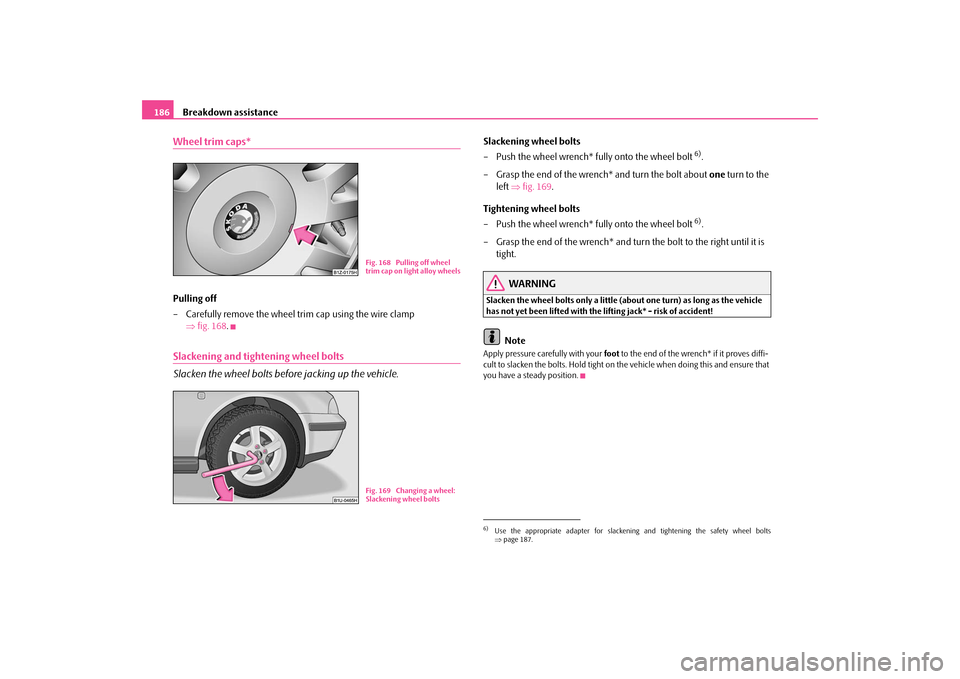
Breakdown assistance
186
Wheel trim caps*Pulling off – Carefully remove the wheel tr
im cap using the wire clamp
⇒
fig. 168
.
Slackening and tightening wheel bolts Slacken the wheel bolts before jacking up the vehicle.
Slackening wheel bolts – Push the wheel wrench* fully onto the wheel bolt
6).
– Grasp the end of the wrench* and turn the bolt about
one
turn to the
left
⇒
fig. 169
.
Tightening wheel bolts – Push the wheel wrench* fully onto the wheel bolt
6).
– Grasp the end of the wrench* and turn the bolt to the right until it is
tight.
WARNING
Slacken the wheel bolts only a little (a
bout one turn) as long as the vehicle
has not yet been lifted with the lifting jack* - risk of accident!
Note
Apply pressure carefully with your
foot
to the end of the wrench* if it proves diffi-
cult to slacken the bolts. Hold tight on th
e vehicle when doing this and ensure that
you have a steady position.
Fig. 168 Pulling off wheel trim cap on light alloy wheelsFig. 169 Changing a wheel: Slackening wheel bolts
6)Use the appropriate adapter for slackening
and tightening the safety wheel bolts
⇒ page 187.
s2g8.b.book Page 186 Tuesday, April 7, 2009 8:53 AM